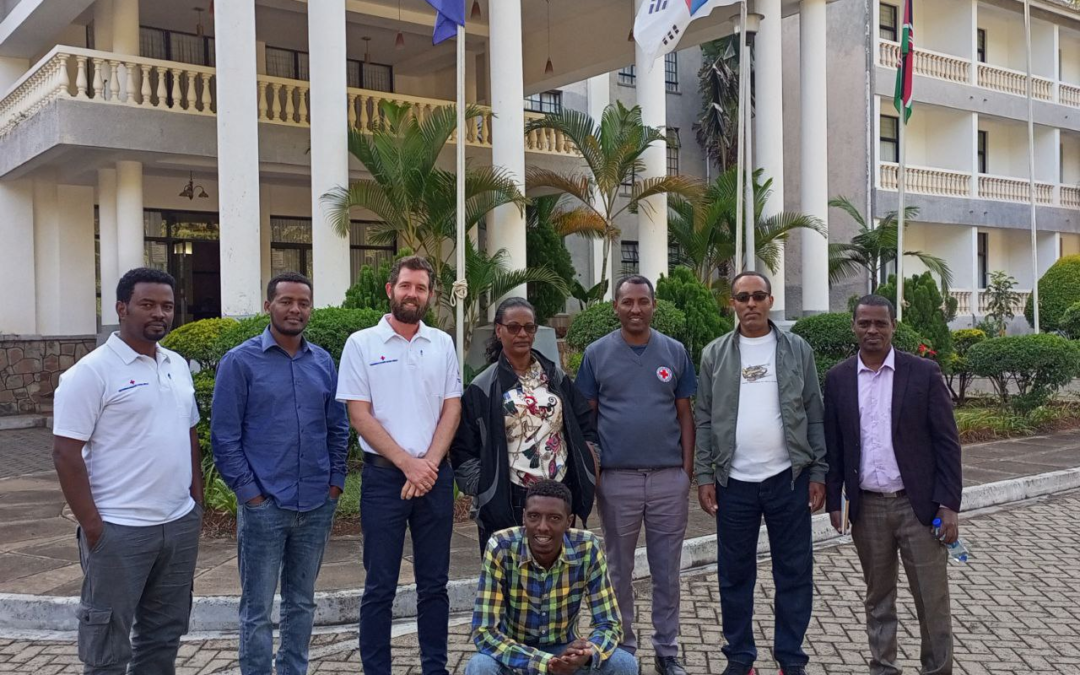Written by Temesgen Geremew, AutRC Project Manager
The 5-years Skybird programme, which is funded by the Austrian Development Agency and implemented by the Austrian Red Cross (AutRC) together with its partners, aims to support the RCRC movement in delivering more effective and gender-sensitive WASH services with the overall objective to contribute to improved living conditions in East Africa. Micro projects are structured in two cycles (Cycle 1=Year 2+3; Cycle 2=Year 4+5) divided by a Mid-term Review. Currently, in Ethiopia, 7 branches are implementing Micro-projects in the cycle 2 program period (November 1, 2021 to October 30, 2022), include: South Omo, Addis Ababa, West Arsi, South Wollo, Illuababor, Harari and Sidama branches.
The programme aims to foster multi-layer knowledge sharing between local, regional and national levels of core partner organizations (AutRC, Ethiopian Red Cross Society (ERCS), Uganda Red Cross Society (URCS), Kenya Red Cross Society (KRCS), etc), as well as with sister societies in the neighboring countries, and also with RCRC external key WASH-related stakeholders such as governments (local and central), CSOs, researchers and entrepreneurs, as well as with other NGOs in the region.
A team from Ethiopian Red Cross society national and branch offices and from Austrian Red Cross country office in Ethiopia conducted experience sharing visit to Kenya Red Cross Society , from October 02 to October 06, 2022. The Ethiopian team consisted of:
- Abera Lulessa, Deputy Secretary General for Support Services at ERCS,
- Gashaw Dagne, Health and WASH manager at ERCS
- Tilahun Bishaw, ERCS South Omo Branch Head
- Baherwessen W/ageray, ERCS South Omo Branch SkyBird Project Coordinator
- Bayissa Adare, Skybird Program Coordinator at ERCS
- Temesgen Geremew, Program manager at AutRC Country Office in Ethiopia
- Sintayehu Bekele, Volunteer at ERCS South Omo Branch
The major importance of this exchange visit is to document lessons from the KRCS on success achieved and challenges encountered from utilization of solar energy for rural water supply system and prepaid smart water meter in Baringo county. Furthermore, having this experience will support ERCS and south omo branch not to repeat mistakes committed by KRCS while installing prepaid water meter and solarization.
The overall objective of this experience sharing and learning visit is to foster the sharing of evidence-based learnings, innovative knowledges, and skills on WASH particularly on Solar energy system for water supply and related interventions from study visits, so as to be used to improve future programme selection, design and implementation in Ethiopia.
October 3, 2022 – Ethiopian team visited KRCS HQ and held discussion with KRCS team.
On October 3, 2020 morning, the Ethiopian team met with the KRCS staff at KRCS HQ office. Dr Asha Mohammed, Secretary General of Kenya Red Cross Society, made an opening shpeech welcoming the team. The KRCS Project Officer briefly presented the overall backgroung of the KRCS, structure of the organization and the current project implementations.
The SG warmly welcomed the team to Kenya and the national society to fetch best experiences. In her welcome speech she mentioned that it is a privilege to host and share experiences to a team from ERCS which is the oldest of all national societies in Africa. She also called her national society founded its current position based an experience they took from ERCS on resource mobilization particularly form the establishment of the capacity building center. She recognized our national society’s contribution for the foundation of the Boma hotel, KRC humanitarian training center, and KRC hospitality training institute. Dr. Aisha continues explain issues related with humanitarian activities where the major responsibility of RCRC movement is. On this topic she said the biggest challenge her national society is facing sustainability of humanitarian service and response activities contribution for preparedness which is building resilient communities for various shocks. So, she said as RCRC movement this is a time to think strategically to link emergency response activities with development nexus. The other important point she mentioned was the Africa CDC cooperation they have ECRS and other national societies and cross boarder branches for manly integrating the support provided communities living around boarder.
In the afternoon, the Ethiopian team visited the KRCS HQ offices, the way project implementions are conducted and managed and the information technology systems used in various activities including in disaster risk responses.
Doris, Health, Nutrition, and social service manager, explained the position of KRC in the national public health emergency where they are cochairing and best use the platform to advocate for service improvement at the community level.
Verah Nyaura is the WASH manager particularly for software part and work closely with WASH engineer and focal point for skybird project at HQ level. She presented the structure/organogram/ of KRCS. In here presentation she depicted the how KRC is structured form the community level to HQ.
In KRC there are: –
- 8 regional KRC committees.
- 47 county branch offices
The major discussion points during the presentation were
- The autonomy of the branches. The difference experience observed her is branches are less autonomous when it comes budget management and pavement administration. In some cases, the National society HQ is responsible in managing branch payroll.
- 50% of county branch offices are self-sustainable
- There is interbranch support but needs detail justification and needs approval from HQ. This will minimize disappointment of staff and volunteers working under strong branch on revenue collection.
Jenga, an IT person who is highly fond of explaining the benefit of digitalization for humanitarian response, in his presentation explained the contribution of Redrossapp for CVA in the humanitarian spectrum. The major benefit of Redross is on beneficiary management particularly on registration, verification and PDM survey. Some of the features of it can be interfaced with ODK data collect and used for payment. The Redross collect integrated with a dashboard created by IT person. In the discussion, how it could be best used this app for MPCA, and the payment effected through banks. Jenga, explained that this app is applicable and can be contextualized locally. What is required is having discussion with the firm and organizing an orientation session.
Shilla Karim, EOD shift leader, explained that KRC EOC Center is operational 24/7 and has toll free hotlines to receive emergency and accident information form the community. The ultimate objective the center is to collect reliable data about emergency in the country and analyze and make ready for informed decision for management. The major sources of information are feedbacks in the social media platform of the national society specially tweets from the twitter filtered and verified with volunteers and county coordinators, toll free hotlines (1199) and weather condition report from government. The types of data and information they receive is not limited to disasters induced from natural and manmade. The HQ center is responsible to respond road accident. In addition to the HQ EOC, there are 5 EOCs in the regions these are
- Kilif
- Garissa
- Baringo
- Samburu
- Tana River
The response Leadtime depends on the type of the disaster, but if the disaster is a fire accident the maximum time may takes it takes 10 minutes to responds after receiving the information.
The center also receives SGBV information from survivors and people who have concern on this regard. Based on the needs of the clients they provide a remote counseling service and having consent they refer survivors to other service providers. To make service provision is confidential, before referring their clients to other institutions, the center mapped out key stakeholders and the service they provide. After the service provision they have a follow up mechanism to the clients weather the service is provide as per the communication or not. They best used this communication channel as one of their feedback and complaint collection mechanism.
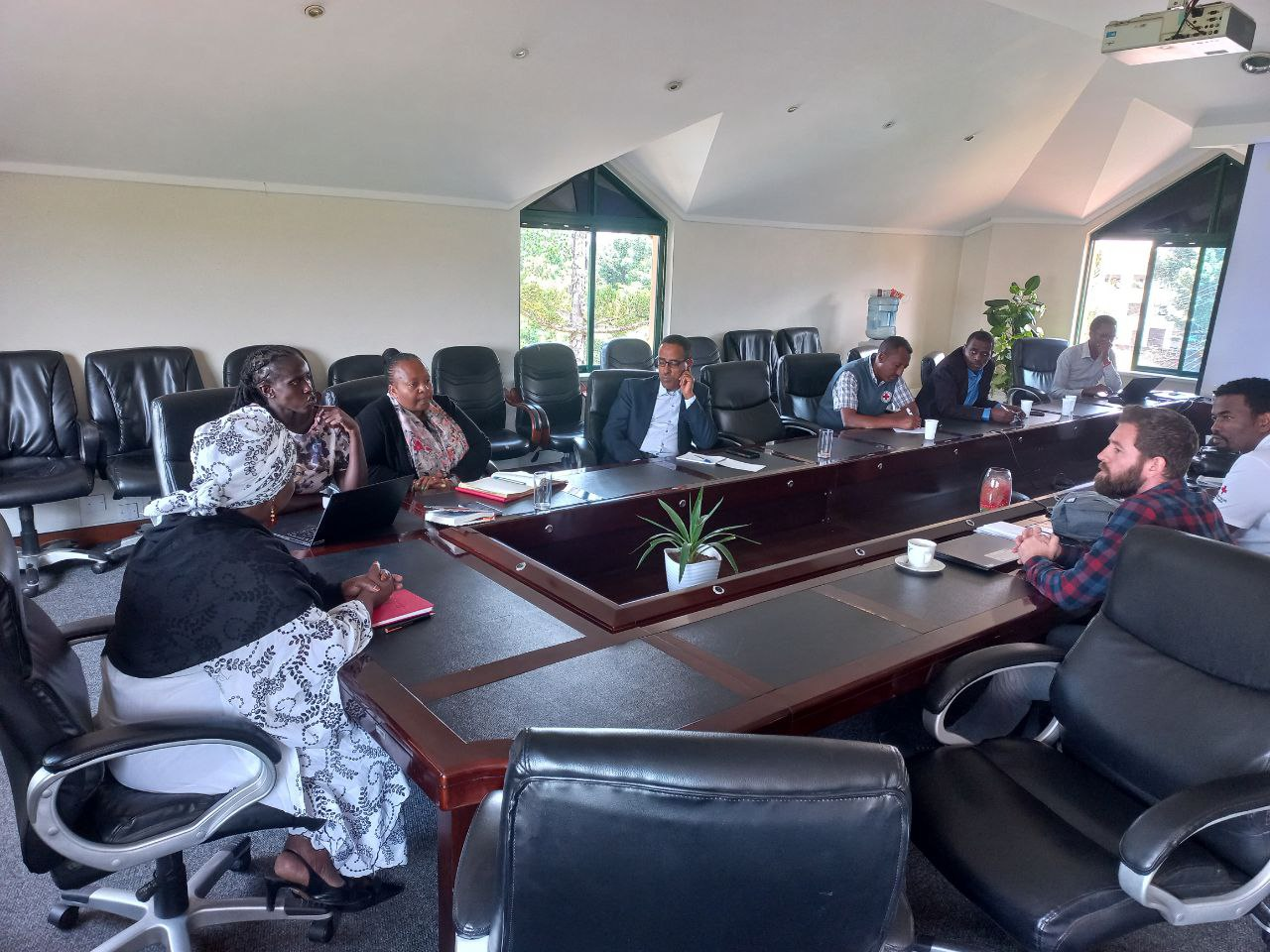

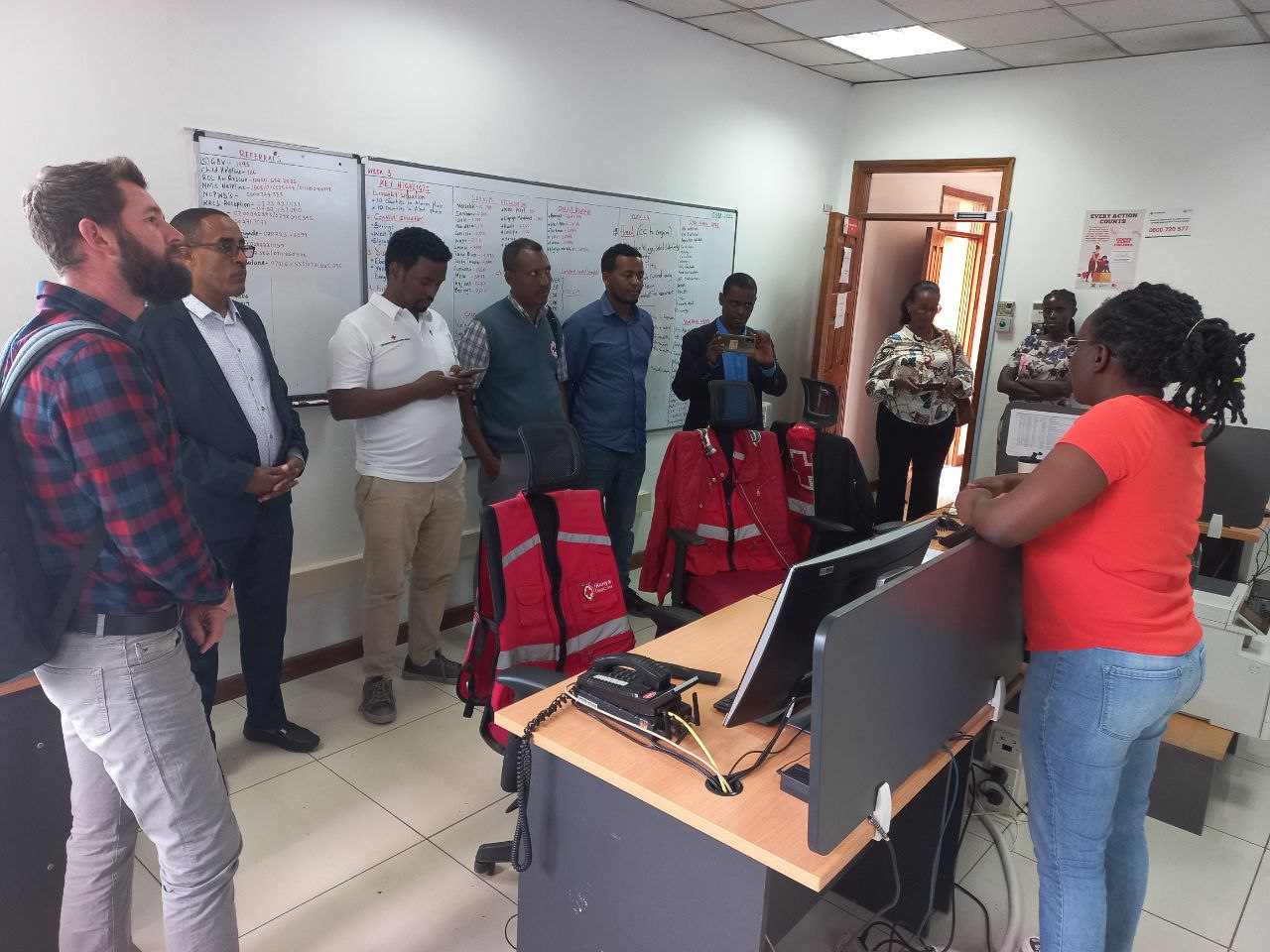

On October 3, 2020 morning, the Ethiopian team met with the KRCS staff at KRCS HQ office. Dr Asha Mohammed, Secretary General of Kenya Red Cross Society, made an opening shpeech welcoming the team. The KRCS Project Officer briefly presented the overall backgroung of the KRCS, structure of the organization and the current project implementations.
The team also visited operations of the other units in KRCS HQ office:
Youth and innovation unit: The unit is very young it is only 2 years of age from establishment. The objective of the unit is to support the national society to contextual the programs to fit youth needs. The unit is also run by youths of various discipline.
Disaster Management (DRM) (Miko department head): DM department is established with two major units
- Disaster Risk Reduction (DRR) unit
- Livelihood unit
Both units are supported by situation room which called Emergency operation center (EOC). As mentioned above under the EOC observation it is a source of information for the national society response activities. DM head mentioned some of the projects undergoing in his department are
- Urban resilient project
- Routine programs focusing on road accident, fire accident and other
- The major disaster” the elephant in the house” is drought
- Flood
- KRC also facilitate certificate for asylum sicker particularly from the great lake country this made the country is at risk of Ebola virus.
Response mechanisms
To make a response is need driven and context specific feasibility assessment and response option analysis are conducted. Where the situation allows CVA is a choice of mechanism that the national society prefers. The tools and approach used for emergency response are
- CVA Redross
- Anticipatory response (Forecast based financing)
- Buy the weak cattle from pastoralists and test antepartum and postpartum slaught the cattle and give the meat to beneficiaries. The minimum payment for some cattle is 4.5M Kenyan shelling. This is a bit challenging response approach because pastoralists don’t will to sell their cattle, and this is time taking service.
- Keeping children in the school for feeding program is another emergency response for long term for pastoralists community.
KRCS position in the county DM
Kenya Red Cross is a cochair national cash working group and is leading organization which is found in the forefront next to government.
The response is usually need based than donor driven. Some donors come and ask us to participate in the response activities in the middle of the response, however our reply for such kind of the request is immediately no we don’t take such kind of role unless otherwise we involved from the beginning of the process.
The KRCS is also providing Ambulance service in the county. However, ambulance operation service is outsourced to another company to provide the service on KRCS behalf, and it is use as one of income generation source. The detail information required from other team members.
Research and learning center unit
Is an independent legal entity established under Kenya red cross to support on research and policy formulation. The scope of the unity is beyond the national society where it computes on calls nationally and internationally and produces income the NS. It is organized with different experts that holds 3 meteorologists, CVA expert, policy analyst, Information management expert and others.
After observing the HQ , the next day which is October 4rd , 2022 the team travelled to Baring county karbanet town where the governor is located.
October 4, 2022 – Ethiopian team visited Baringo County Government Office
The ERCS and KRCS team arrived at Baringo County Government office and welcomed by Baringo County Governor H.E Stanley Kiptis and the office staffs. In this county we mate and discussed with government officials and their cooperation with KRCS. Particularly, the team organized a discussion session with county community health management committee team.
.
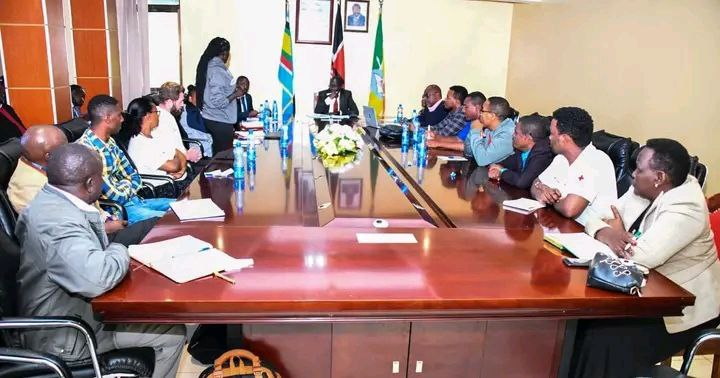
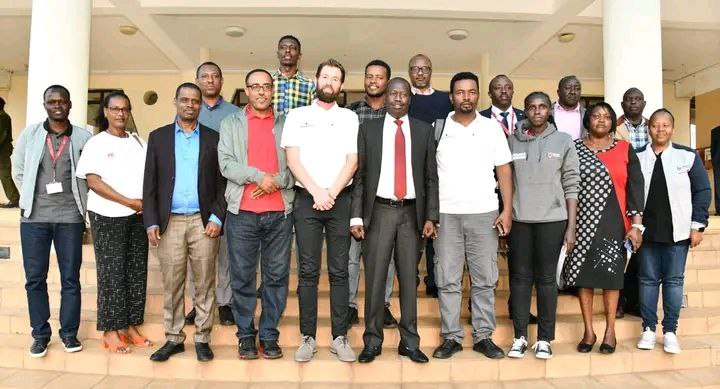
October 5, 2022 – Ethiopian team visited KRCS Baringo branch office and project sites (Suwa Kaapei, Ntepes, Ildaripoi, Sintaan, Leswaa):
On october 5, 2022 morning, the team visited KRCS Baringo branch office and held discussion with the branch staffs. The branch has 3 operation offices and other subcounty coordination offices. The branch has 11 officers, and the major thematic areas of project are WASH, health, and nutrition, expanded program of immunization (EPI) and DRM. This is the branch where a skybird program is under implementation. The major objective of the project is providing flood resilient latrine option to the community usually affected by flood.
The branch has 3 operation offices and other subcounty coordination offices. The branch has 11 officers, and the major thematic areas of project are WASH, health, and nutrition, expanded program of immunization (EPI) and DRM. This is the branch where a skybird program is under implementation. The major objective of the project is providing flood resilient latrine option to the community usually affected by flood.
The next destiny of the mission was SUWA KAAPEI community where the scope of the mission anchored. The location is found under Baring county and Margaret subcounty. The community has a water supply source which was drilled by another organization before 17 years in 2005. The water system is supported with solar pump. This water source provides service to 514 households and for about 3000(52% are women) population residing in the area. In this community water supply system there is smart prepaid water meter and a solarized water source supported by skybird project. The smart prepared meter is installed to support the water supply management in the community.
The effective and efficient management of water supply in this community means: –
- Target people can get water without limitation of time and in the absence of water care at water point.
- Support the operation and maintenance of water supply system.
- Exemption of the poorest HHS from water fee.
- Proper management of finance particularly ensure transparency and accountability of water user committee to the community.
How the smart water meter works?
The smart water meter works relacing the usual taps and connected with a water tanker mounted near the kiosk through inlets from the water tanker . There are three types of token( the blue one for the client, gray one for water care and orange one is for maintenance service.


The interesting part of this device is it is digitalized, and all payments effected with M-PESSA which is a mobile money and has alternative to collect fees in cash(note). However, the water caretaker exchanges the cash(note) in to digital money to get the water supply service by the tokens. The other important thing is the amount of to be poured in the water collection/fetching material is culverted to be 20 liters and the client can tilt the jerrican util it gets full. This also prevents misuse of water and wastage. The feature of the meter is it refunds the used amount of money to the customer.
The water supply system has a management committee composed of 11(4 women) people. The committee members serve voluntarily and to provide community service. The chairperson and the secretory are man and vice chairperson and treasury are women.
The amount of fee per volume of water served is decided by the community which is 2000.00 Kenya shelling per 20 liters of water. For major maintenance work the local ministry of water takes responsibility to maintain the system. For small operation and maintenance there are trained local plumbers invited and engaged on the maintenance service. The committee members have consultative meeting once every quarter. However, they meet usually to manage the running of water supply system. For the water supply system to operate properly there are employees(water caretaker and 2 guards) who are paid from the income of the water supply system.
After installation of smart water meter, the community expanded the service to school which has 800 pupils and to another village. The school get water supply with subsidized cost and pay every month as per the water meter count installed to it. The major impact of the project in this area is 180 the most vulnerable individuals are exempted from paying fee which was only 50 HHs.
The contribution of the water supply to improve health community is witnessed by the county public health office. The public health officer mentioned before the smart water installed, there was frequent interruption of water supply service because of various factor and this was leading people to cope with the challenge by searching for contaminated water source. The contaminated water source was leading people water borne diseases such as cholera and dysentery. However, after the installation of the smart water meter, the health of the community improved. Furthermore, the water supply service provided to the school community contributed to reduce school absentee and increased retention of schoolgirls in the school. In addition to MoH and school principal , ministry of water focal person also witness that this smart prepaid water meter is the first in its kind in the county and the local government ahs plan to expand to other villages.
The biggest challenges the committee is facing is finding the right amount of token as per number of beneficiaries. 1 token const 5000.000 Kenya shelling.
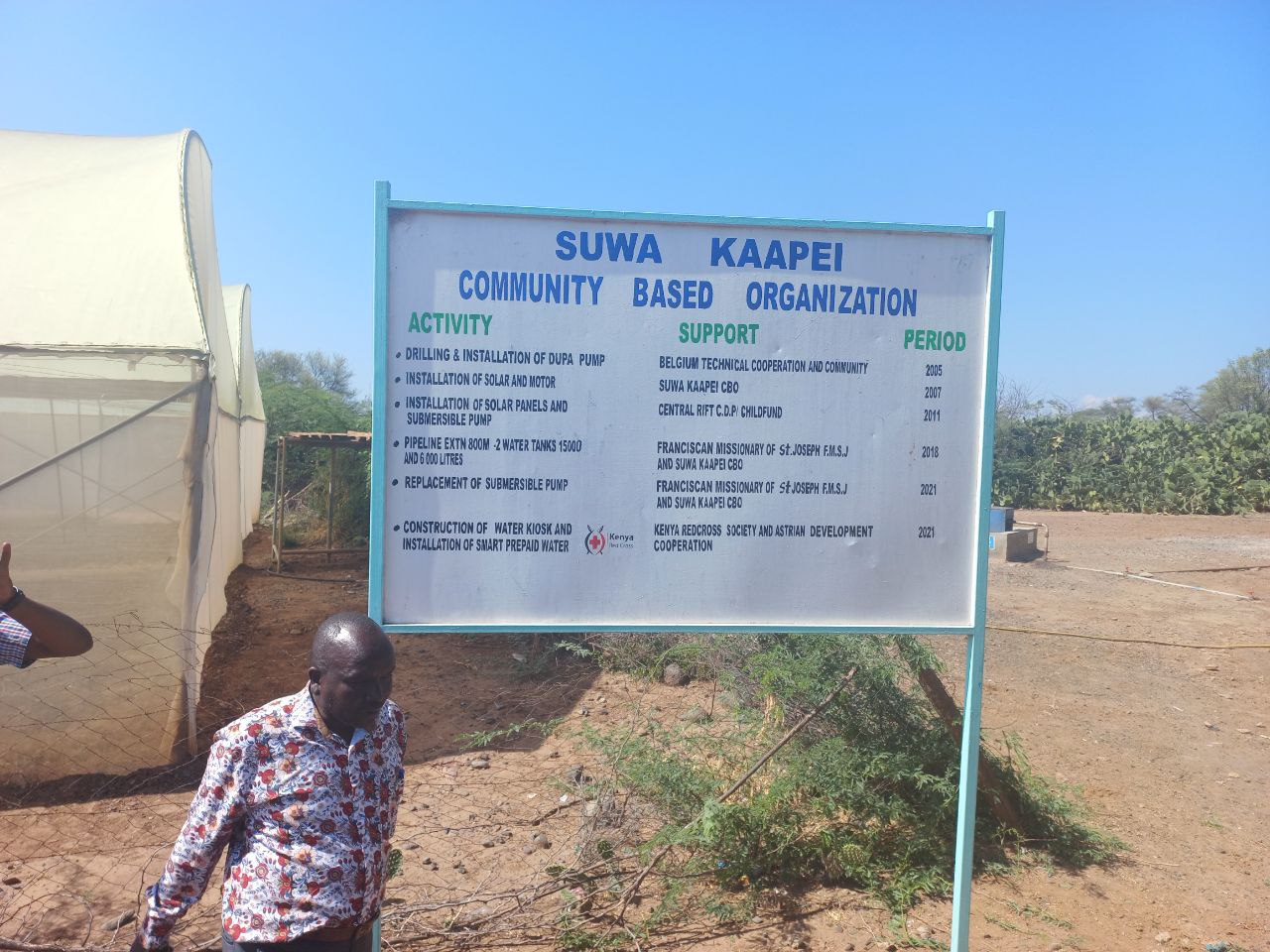



After vising and having concrete discussion with SUWA KAAPE community water management committee , the team direct to another village with the same smart prepaid water meter. The village is identified as NTEPES.
.
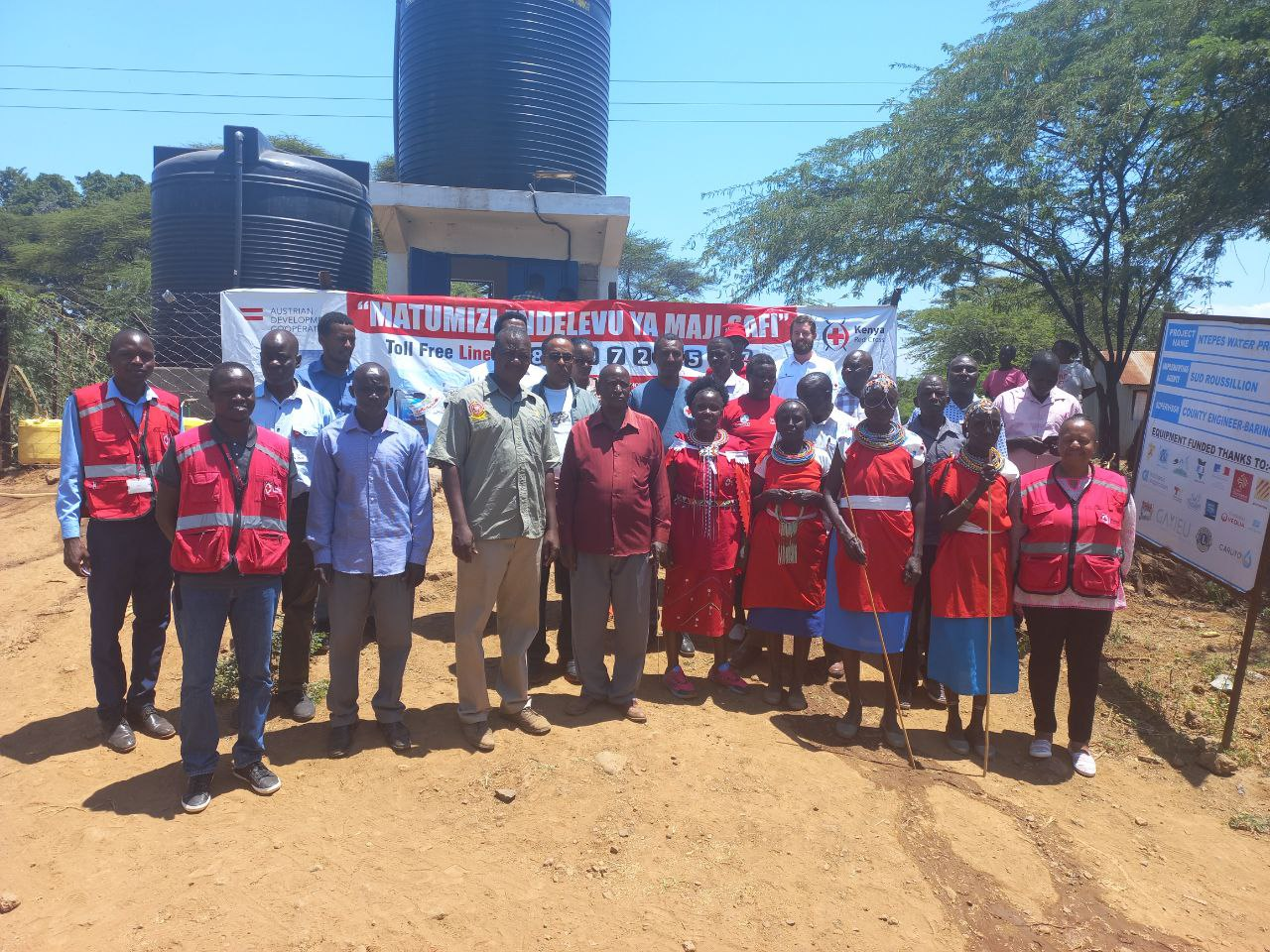

After the smart prepaid water meter exchange visit , the other component of skybird project in the area is supporting/assisting/ individuals to have their own household latrine through CLTSH approach with county health team. Fortunately, on he day of the mission to that area, four villages were ready to declare their village from for open defecation.

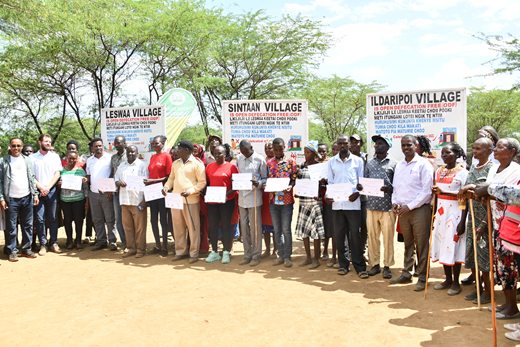
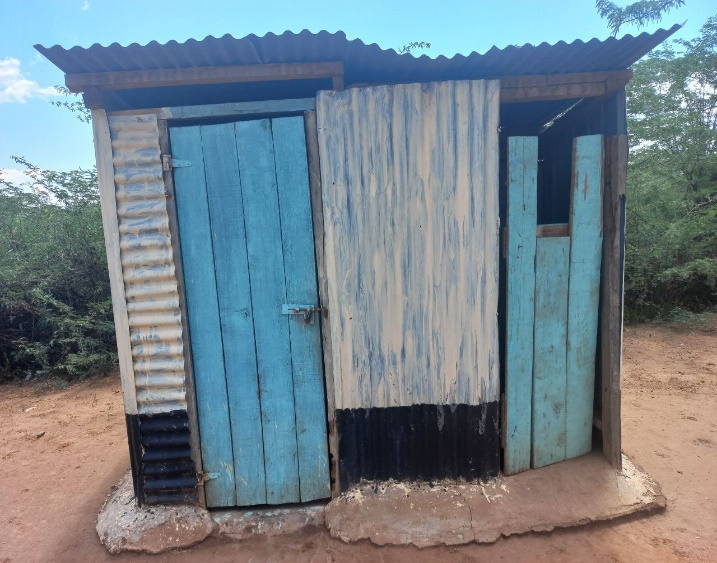

Some of team members shared also experiences on CLTS particularly to work on sustainability and encouraged the community and natural leaders with community health volunteers to work on upgrading the sanitation ladder beyond ODF. The project team and coordinator also have plan create link with soli brick producers to supply bricks for HHs who have willingness to pay to improve their own latrine. The sanitation marketing concept in the area is at its infant stage and needs further support.
The next visit was to Ilng’arua Primary School which is a boarding primary school in the area where soil brick producers organized and were build inf one latrine in the compound for student. The SMEs are producing 65 bricks from 1 sac cement and soil by locally made mold.



One of the concerns raised during the soil brick production was the quality assurance issue and better to test at induvial HH than in the school. Nevertheless, once the construction in the school already started, the project coordinator should closely monitor the construction process. The kitchen guard tried in the school compound also one of our visit areas where there is a trial of preparing seedling on seedbed and transplant to empty sack filled with soil.
Lessons learned
- Close cooperation among KRCS and government authorities. This helped KRCS to sure fund for DRM.
- In the area of pastoralist community for drought repose , buying the weak animal and provide meat to vulnerable to east.
- Diversified resource mobilization/IGA/ streams. The Boma hotels, hospital training institute, research and learning unity , Ambulance operation , KRCS is also the first choice for donors.
- Water supply digitalization (smart prepaid water supply) this helped the community to get water whenever the need and minimized misuse and wastage of water.
- Integration of sanitation and livelihood .. CLST and SMEs producing soil bricks.
- Gender balance and empowerment in HQ and county level.
- Ambulance operation outsourcing
Way forward
- ERCS South omo branch to prepare an action plan for procurement of smart prepared water meter.
- Health and WASH manager prepare to up take sanitation and hygiene experiences where it fits the context.
- Resource mobilization unit with branches to take away lessons to mobilize resource for response and routine service. This includes working closely with local government on disaster response.
- Youth and volunteers’ engagement in program implementation and resource mobilization
- DSG and other management committee to work on gender balance in ERCS staff and volunteers
